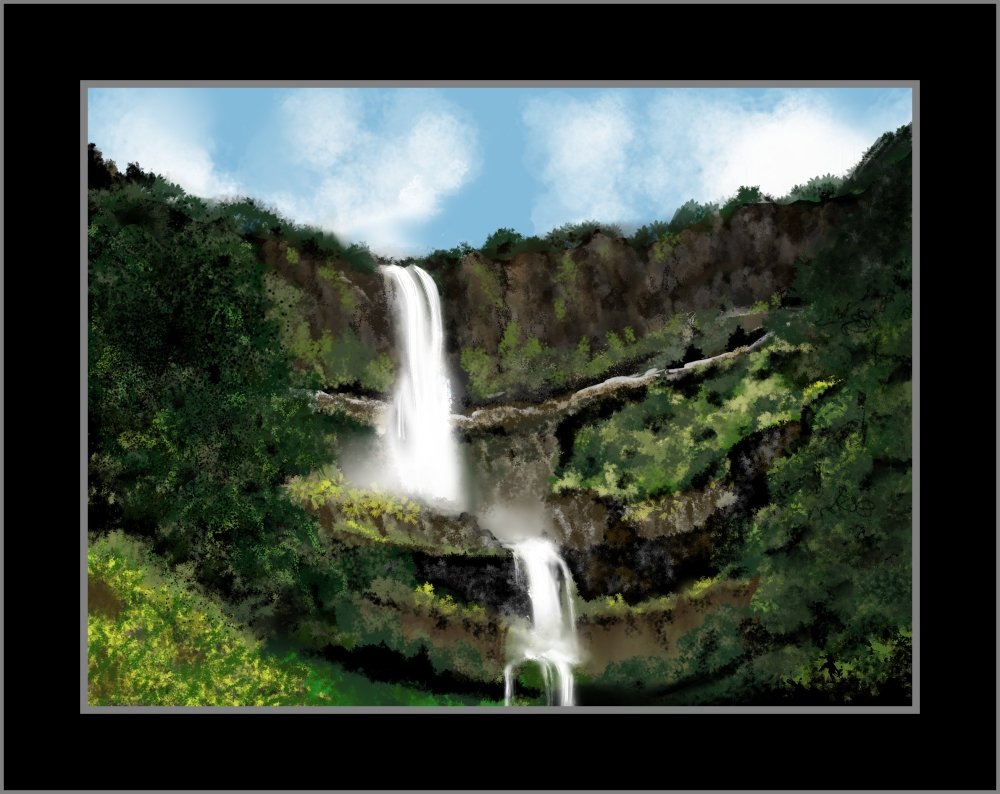Snippets of Information
Location - Geographical areas / Infrastructure
in Maharashtra
* 16 Oct 2024

Digital Painting using Infinite Painter - Bhambavli Vajrai Waterfall, Satara, Maharashtra. Photo ref: travelsetu . com
Bhambavli Vajrai Waterfall, one of the the highest waterfalls of
India falls in 3 stages. Another high waterfall is the Nohkalikai Falls
in Meghalaya. Vajrai Waterfall forms the source of the Urmodi river. This
perennial waterfall is situated in the district of Satara in western
Maharashtra (Sahyadri hills) near the Bhambawali village, about 5 km
from Kas Flower Valley and 2 km from Bhambavli Flower Valley. There are
many small caves near the
falls.
* 28 Nov 2023
Varandha Ghat is a mountain passage in the Western Ghats. It cuts
the Western ghats to join the town of Bhor to Konkan and thus connects
Pune and the Konkan region. The place has an abundance of natural beauty
and lush green forests, tall mountains, wildlife and waterfalls in
monsoons are common place. Not as famous as the Tamhini ghat, Varandha
ghat is still a great weekend getaway from Pune. The road from Katraj
was National Highway 4.
Scenic spots along the way: a dam called Bhatghar dam which has a hydel power station with it, a small waterfall.
There is a point at which the mountain takes a U-bend. On one side the
roads goes, cut into a hill bend and on other side, beyond the valley
are steep green hills and after a 45 minutes ascent and crossing of a
mountain stream, is the small village of Shivthar.
Shivthar Ghal, lying at the base of the Sahyadri, is an important
place for the Hindus in Maharashtra. It was at a cave in this place,
that Samarth Ramdas, a famous guru of the region, stayed for 22 years
and wrote his book ‘Dasbodh‘. It was also at this place that Chatrapati
Shivaji’s first meeting with Samarth Ramdas took place. A monastery
Samartha Seva Mandal, dedicated to the guru is built around the cave.
This place is an abode of silent beauty, thick vegetation, mountains
flanking it from all sides, waterfalls and streams. A big
waterfall lies just next to the cave, ending in a stream which flows
below the monastery.
Source: A DRIVE TO VARANDHA GHAT AND SHIVTHAR GHAL, Ekta and Puru, Shadows Galore blog
* 24 Oct 2022

Kondana Caves
Kondana Caves are located in the midst of a dense forest near Kondana
Village, 33 kilometres north of Lonavala and about 15 kilometres from
Karjat, Maharashtra. These caves consist of intricate and delicate
carvings of Buddhist architecture. Although an earthquake in 1900
damaged some parts of the caves, the existing structures are worth
seeing. A waterfall flows from above the caves.
The Kondana Caves were discovered during an excavation in the
1st century BC. The cave group is one of the three sister caves along
with Bhaje Caves and Karla Caves. They were majorly used by the Buddhist
monks for meditation purposes, especially during the monsoons. It's a
set of 16 caves that house the Chaitya, some intricately designed
ancient sculptures, serene Viharas with meditation pods and Stupas that
depict Buddhist history and are a perfect illustration of the old
methods of Buddhist architecture. The rock-cut structures carved with
immense finesse and symmetry are of religious significance to the
Buddhist community and also one of the few still existing in
Maharashtra.
The ancient carvings and sculptures feature men and women in elegant
dance postures. The embellishments are held together by massive
octagonal pillars. Each and every corner of these caves is graced with
amazingly detailed craftsmanship. The meditation pods are a unique
feature of these caves and provide the perfect place to meditate and
introspect.
The Kondana Caves face north-west and are hidden behind the dense
forest. The entire complex is divided into four caves. The first cave is
the arch-shaped Chaitya cave which extends over 65 feet and stands 28
feet tall & 25 feet wide. The Chaitya cave lies to the south-west of
the cave group. The cave houses a Dagoba, which is a dome-shaped shrine
with a diameter of over 9 feet and is believed to contain relics of
Buddhist Saints. The nave in front of the Dagoba is about 14 feet wide
and 49 feet long. The nave was surrounded by thirty columns which are
now in ruins, but their positions can be determined if seen carefully.
To the north-east of the cave group is the Vihara. Although the front
portion of the porch is completely ruined, the portion at the left end
is quite intact. About 29 feet long and over 23 feet wide, the cave
houses fifteen pillars, a raised alcove and a small Dagoba under a
Chaitya arch. Each side of the Vihara hall has six cells with beds for
the monks.
The third cave is also a Vihara with nine cells which are completely in ruins today.
The fourth cave is a set of another 9 cells, which now look like a
hollow under the cliff. Beyond this cave lies a reservoir which is now
filled with mud. The rest of the ruins consist of two more cells under
an over-hanging rock and another small reservoir.
Source: holidify.com
|